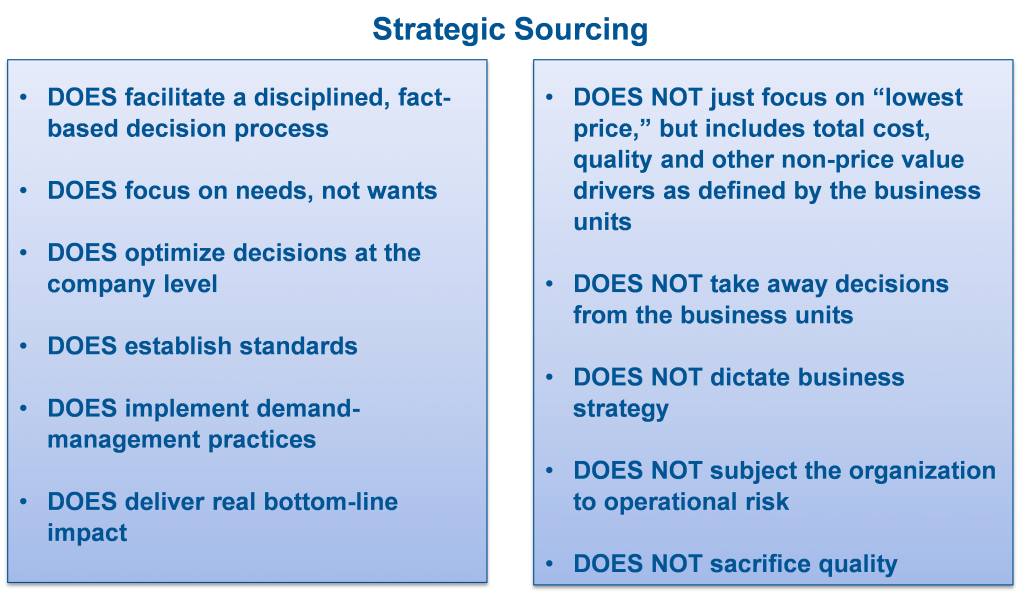Last week we started exploring “Selling the Change” and approaching it from a sales perspective. We all recognize that change is hard. As professionals in a Shared Services environment (Procurement, Supply Chain, Strategic Sourcing) one of our primary roles is that of a change agent as we are trying to play a more strategic role within our organization. Getting suppliers to work with us under a more strategic context is the easy part. Getting our own organization (sometimes even our own Procurement people) to do things differently is another story. Building a better process or adding new technology is not how you make change happen. It must be sold!!! Without the cooperation and acceptance of your internal business partners, you will never be successful. So, “Sell the Change” you must.
Here are the Top Ten Critical Selling Principles:
- Principle #1: Identify your Market Segment (stakeholders)
- Principle #2: Know how the customer (stakeholder) likes to receive communication
- Principle #3: Build the Brand
- Principle #4: Selling the Product
- Principle #5: Educate your customer (stakeholder)
- Principle #6: Develop Effective Collateral
- Principle #7: Establish a Need / “Burning platform”
- Principle #8: Highlight the Value of Change
- Principle #9: Anticipate Objections
- Principle #10: Illustrate what Others have Achieved
Last week we took a closer look at the First 5 Principles. Now, let’s take a look at the Last 5 Principles:
Principle #6: Develop Effective Collateral
Under this principle you may have a picture in your head of a sales person whipping out a fancy, slick brochure or folder that points out all of the “features” they are offering. But effective collateral takes what may be a complex process or thought and makes it simple. Decide on the key messages you are trying to deliver and make them:
- Simple but not simplistic
- Creative as well as analytical
- Always, Always, answer the question “so what”
Principle #7: Establish a Need / “Burning Platform”
This principle is critical because in order to sell the change you need to find a compelling reason for someone(s) to change. In many organizations, change may be required simply to survive – “if we don’t make this change, we will go out of business”. In other cases, the change can be positioned more positively – “this new system will give us a competitive advantage” OR “this leadership program will allow you to be in-line for a promotion”. Regardless of the reason, this must be presented to your customer (stakeholder) and will be at the foundation of your sales pitch.
Principle #8: Highlight the Value of Change
Have you ever heard of WIIFM or What’s In It For Me / Them? This is also a critical component of your sales presentation. Understanding what is valued by your customer/ stakeholder (their Value Drivers) is necessary for a “sale”. You need to sell the benefits to them, which means that your pitch must be customized to each stakeholder. In addition, if your solutions are designed based on the value drivers of your customer adoption, will be easier as well.
Principle #9: Anticipate Objections
This principle is also important. Take the time up front to anticipate any objections your customer/stakeholder will have and build them into your approach. For example, here is one of my favorites:
Being prepared to respond to any objections will let the stakeholder know that you took the time to address both their needs and concerns.
Principle #10: Illustrate What Others Have Achieved
Everyone likes to hear what others have achieved and accomplished. In addition, stakeholders may not be comfortable being on the leading (bleeding) edge of change. Providing benchmark information will go a long way to help sell the change.
Well, we have now covered the Top Ten Critical Selling Principles which we applied to “Selling the Change”. Here are some other tips to consider:
- Sell to all levels of the organization – not just executives
- Always pre-sell to executives to make certain you have
political coverage - Involve your non-Sourcing / Supply Chain team members
to sell too - Sell early and often
- There is no such thing as relevant over communication
- Benefits sell, features don’t
- Tailor your “pitch” – different audiences require different messages
By the way, do you know who should be the first person you hire for any major change initiative? It should be a sale / marketing professional . . . .think about that 🙂 !
Let us know what you think and join in the conversation . . . . . .



1 Comment
Do you ever do one day seminars? Would you considers it on any one part of it?
Pleas advise. 616.901.3788
Thomas Cole